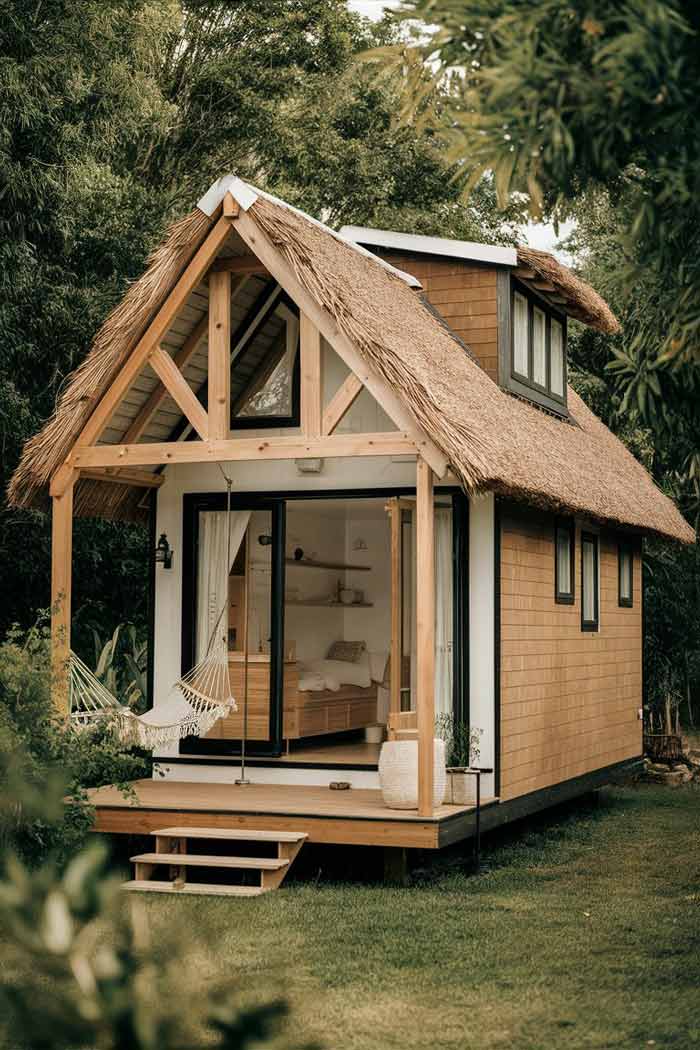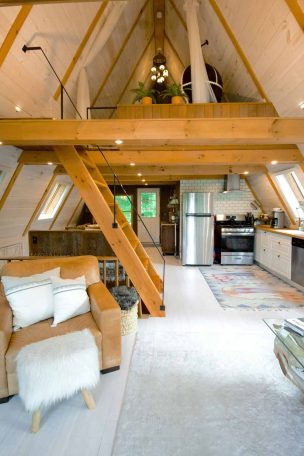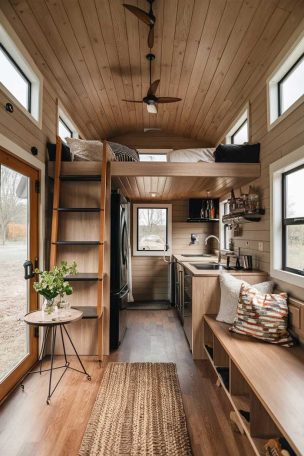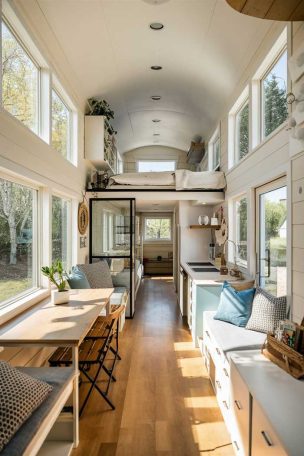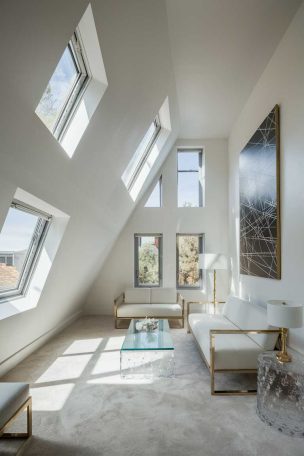Tiny house living has become more than just a trend; it’s a movement towards sustainable, minimalist living that’s gaining traction worldwide. As our planet faces increasing environmental challenges, the appeal of downsizing and reducing our carbon footprint has never been stronger. But how can we make these small spaces not just livable, but truly eco-friendly?
This comprehensive guide will explore a wide range of eco-friendly practices tailored explicitly for tiny house living. From innovative design principles to cutting-edge technologies and lifestyle adaptations, we’ll cover everything you need to know to create a sustainable, comfortable, and environmentally conscious tiny home. Whether you’re a seasoned tiny house dweller or just starting to explore this lifestyle, you’ll find valuable insights and practical tips to make your small space as green as possible.
Let’s dive in and discover how to maximize sustainability in minimal square footage!
Sustainable Design Principles
The foundation of an eco-friendly tiny house lies in its design. By incorporating sustainable design principles from the outset, you can create a home that’s not only environmentally friendly but also energy-efficient and comfortable. Let’s explore some key design strategies that can make a big difference in your tiny house’s ecological footprint.
Passive Solar Design
Passive solar design is a game-changer for tiny houses. It’s all about using the sun’s energy to naturally heat and cool your home, reducing your reliance on artificial heating and cooling systems. Here’s how to make it work:
- Optimal orientation: Position your tiny house so that its longest wall faces south (in the Northern Hemisphere). This maximizes solar exposure during winter months when the sun is lower in the sky.
- Strategic window placement: Install larger windows on the south-facing wall to let in plenty of sunlight during winter. Use smaller windows on the north side to minimize heat loss.
- Thermal mass materials: Incorporate materials like concrete, stone, or adobe into your design. These absorb heat during the day and release it slowly at night, helping to regulate indoor temperatures.
- Overhangs and shades: Design roof overhangs or install retractable shades that block the high summer sun while allowing the lower winter sun to enter. This prevents overheating in summer without sacrificing warmth in winter.
By thoughtfully implementing these passive solar design elements, you can significantly reduce your energy needs and create a more comfortable living space year-round.
Natural Light Maximization
In a tiny house, every inch counts – and that includes vertical space! Maximizing natural light not only reduces your need for artificial lighting but also makes your small space feel larger and more open. Here’s how to flood your tiny house with natural light:
- Large windows and skylights: Don’t be afraid to go big with your windows, especially on the south-facing wall. Skylights can bring light into the heart of your home, even in areas that can’t accommodate traditional windows.
- Light tubes: For spaces that can’t fit windows or skylights, consider installing light tubes. These clever devices use reflective material to funnel sunlight from your roof into interior spaces.
- Sliding doors: Replace traditional doors with sliding ones where possible. They take up less space and, when made of glass, allow light to flow freely between areas.
Remember, the goal is to create a bright, airy space that feels connected to the outdoors. This not only saves energy but also enhances your overall well-being.
Efficient Space Utilization
In a tiny house, every square inch matters. Efficient space utilization is key to creating a comfortable living environment while minimizing your environmental impact. Here are some strategies to make the most of your limited space:
- Multifunctional furniture and spaces: Invest in furniture that serves multiple purposes. A sofa that converts into a bed, a dining table that doubles as a workspace, or stairs that incorporate storage are all great examples.
- Vertical storage solutions: Think up, not out! Use tall shelving units, wall-mounted storage, and ceiling-hung organizers to maximize your storage capacity without eating into your living space.
- Outdoor living area integration: Extend your living space beyond the walls of your tiny house. A well-designed deck or patio can serve as an additional room during good weather, reducing the need for interior space.
By implementing these space-saving strategies, you’ll create a more functional living environment while reducing the overall size – and environmental impact – of your tiny house.
Energy Efficiency Strategies
Energy efficiency is a cornerstone of eco-friendly tiny house living. By minimizing energy consumption, you’re not only reducing your carbon footprint but also saving on utility costs. Let’s explore some key strategies to make your tiny house as energy-efficient as possible.
Insulation and Temperature Regulation
Proper insulation is crucial in a tiny house, where every bit of heat gain or loss is noticeable. Here’s how to keep your tiny home cozy and energy-efficient:
- High-efficiency insulation: Opt for high-quality insulation with a high R-value. Spray foam insulation is an excellent choice for tiny houses due to its superior insulating properties and ability to fill small gaps and crevices.
- Structural Insulated Panels (SIPs): Consider using SIPs for your walls and roof. These prefabricated panels provide excellent insulation and reduce thermal bridging, making them ideal for tiny houses.
- Air sealing techniques: Pay close attention to air sealing during construction. Use caulk, weatherstripping, and expanding foam to seal any potential air leaks around windows, doors, and other openings.
Remember, a well-insulated tiny house requires less energy to heat and cool, leading to significant energy savings over time.
Energy-Efficient Appliances and Lighting
In a tiny house, every watt counts. Choosing energy-efficient appliances and lighting can dramatically reduce your energy consumption:
- Energy Star rated appliances: Invest in appliances with high Energy Star ratings. Look for compact, energy-efficient models specifically designed for small spaces.
- LED lighting: Replace all light bulbs with LED options. They use up to 75% less energy than incandescent bulbs and last much longer.
- Smart home technology: Implement smart home devices to optimize your energy usage. Smart thermostats, lighting controls, and energy monitoring systems can help you track and reduce your energy consumption in real-time.
By choosing efficient appliances and lighting, you’ll significantly reduce your tiny house’s energy demands without sacrificing comfort or functionality.
Renewable Energy Integration
Integrating renewable energy sources into your tiny house design can help you achieve energy independence and further reduce your environmental impact:
- Solar panel installation: Solar power is an excellent option for tiny houses. Calculate your energy needs and design a solar system that can meet them. Consider using flexible or thin-film solar panels that are lighter and can conform to curved surfaces.
- Battery storage systems: If you’re aiming for off-grid capability, invest in a high-quality battery storage system. This will allow you to store excess solar energy for use during cloudy days or at night.
- Alternative energy sources: Depending on your location, consider supplementing your solar system with other renewable sources. Small wind turbines or micro-hydro systems can be effective in certain environments.
When designing your renewable energy system, it’s crucial to accurately assess your energy needs and account for seasonal variations. A well-designed system will provide reliable power while minimizing your reliance on non-renewable energy sources.
Water Conservation Techniques
Water conservation is a critical aspect of eco-friendly tiny house living. By implementing smart water-saving strategies, you can significantly reduce your water consumption and environmental impact. Let’s explore some effective techniques for conserving water in your tiny home.
Rainwater Harvesting
Harvesting rainwater is an excellent way to reduce your reliance on municipal water supplies and make the most of natural resources. Here’s how to implement a rainwater harvesting system in your tiny house:
- Collection system design: Design your tiny house roof to efficiently channel rainwater into gutters and downspouts. Consider using a pitched roof to maximize collection potential.
- Filtration and storage solutions: Install a first-flush diverter to remove initial contaminants, then direct the water through a filtration system before storing it in tanks. For tiny houses, compact above-ground or underground storage tanks work well.
- Integration with plumbing: Connect your rainwater system to your plumbing for non-potable uses like toilet flushing, laundry, and outdoor watering. This can significantly reduce your freshwater consumption.
Remember to check local regulations regarding rainwater harvesting, as requirements can vary by location.
Greywater Recycling
Greywater recycling is another effective way to conserve water in your tiny house. By reusing water from sinks and showers, you can dramatically reduce your freshwater needs:
- Simple systems for reuse: Install a basic greywater diversion system that channels water from your sink and shower directly to your toilet for flushing or to your outdoor plants for irrigation.
- Filtration considerations: If you plan to store greywater for any length of time, consider implementing a simple filtration system to prevent odors and bacterial growth.
- Compliance with regulations: Be sure to research and comply with local regulations regarding greywater reuse. Some areas have specific requirements for greywater systems.
Greywater recycling can be particularly effective in tiny houses, where the close proximity of fixtures makes installation relatively simple.
Water-Efficient Fixtures
Installing water-efficient fixtures is one of the easiest ways to reduce water consumption in your tiny house:
- Low-flow showerheads and faucets: Choose models that maintain good water pressure while using less water. Look for WaterSense labeled products for assured efficiency.
- Dual-flush toilets or composting toilets: Dual-flush toilets allow you to use less water for liquid waste. Alternatively, consider a composting toilet, which uses no water at all and provides valuable compost for your garden.
- Water-saving appliances: If your tiny house includes a dishwasher or washing machine, opt for models with high water efficiency ratings.
By combining these water conservation techniques, you can dramatically reduce your water usage, lowering both your environmental impact and your utility bills.
Sustainable Materials Selection
Choosing sustainable materials for your tiny house is crucial in minimizing its environmental impact. From construction materials to finishes, every choice you make can contribute to a more eco-friendly home. Let’s explore some sustainable material options for your tiny house.
Reclaimed and Recycled Materials
Using reclaimed and recycled materials not only reduces waste but also adds character to your tiny house. Here’s how to incorporate these materials effectively:
- Sourcing reclaimed wood: Look for salvaged wood from old barns, factories, or demolished buildings. This can be used for framing, flooring, or decorative elements. Be sure to check for and treat any potential pest issues.
- Recycled metal roofing: Consider using recycled metal for your roof. It’s durable, long-lasting, and often contains a high percentage of recycled content.
- Repurposed items for interior finishes: Get creative with repurposed items for your interior. Old doors can become countertops, wine bottles can be transformed into light fixtures, and recycled glass can be used for backsplashes.
Using reclaimed materials often requires more planning and flexibility in your design, but the environmental benefits and unique aesthetic are well worth the effort.
Eco-Friendly Building Materials
When new materials are necessary, opt for those with a lower environmental impact:
- Bamboo flooring and wall coverings: Bamboo is a rapidly renewable resource that makes an excellent alternative to hardwood. It’s durable and comes in a variety of styles.
- Cork for insulation and flooring: Cork is another sustainable option that provides excellent insulation properties and can be used for flooring. It’s naturally antimicrobial and fire-resistant.
- Lunawood Thermowood for exterior cladding: This thermally modified timber is durable, chemical-free, and has a lower environmental impact than many traditional cladding materials.
When selecting these materials, look for certifications like FSC (Forest Stewardship Council) to ensure they come from responsibly managed sources.
Non-Toxic Finishes and Treatments
The finishes and treatments you use in your tiny house can have a big impact on indoor air quality and overall environmental impact:
- Natural paints and sealants: Choose paints and sealants made from natural ingredients like clay, milk, or plant-based oils. These products release fewer volatile organic compounds (VOCs) into your living space.
- Formaldehyde-free adhesives and resins: When using engineered wood products or installing cabinetry, opt for those made with formaldehyde-free adhesives to improve indoor air quality.
- Low-VOC options for all interior finishes: From floor finishes to countertop sealants, choose low-VOC options to minimize off-gassing and maintain healthy indoor air quality in your small space.
Remember, in a tiny house, you’re living in close proximity to all materials and finishes, so choosing non-toxic options is particularly important for your health and well-being.
Waste Reduction Strategies
Minimizing waste is a key principle of eco-friendly tiny house living. By implementing effective waste reduction strategies, you can significantly decrease your environmental impact and potentially save money. Let’s explore some practical ways to reduce waste in your tiny house.
Composting Systems
Composting is an excellent way to reduce organic waste and create nutrient-rich soil for gardening. In a tiny house, space-efficient composting solutions are key:
- Compact composting toilet options: Composting toilets eliminate water usage and transform human waste into usable compost. Models like the Nature’s Head or Separett Villa are popular among tiny house dwellers for their efficiency and odor control.
- Kitchen waste composting solutions: For food scraps, consider a small countertop compost bin or a compact tumbling composter that can be kept outside. The Bokashi composting method is another space-efficient option that works well for tiny houses.
- Integration of compost in tiny house gardening: Use your compost to fertilize container gardens or raised beds around your tiny house. This creates a closed-loop system where your waste becomes a valuable resource.
Remember to check local regulations regarding composting, especially when it comes to human waste composting.
Recycling and Upcycling
Effective recycling and upcycling can significantly reduce the amount of waste your tiny house produces:
- Designing built-in recycling stations: Incorporate a compact, multi-bin recycling station into your tiny house design. This makes it easy to sort recyclables and ensures recycling becomes a habit.
- Creative upcycling of materials: Before discarding items, consider how they might be repurposed. Old clothing can become cleaning rags, glass jars can be used for storage, and worn-out furniture can be refurbished or repurposed.
- Minimizing construction waste: During the building process, carefully plan material use to minimize offcuts. Any leftover materials can often be used for smaller projects or donated to local building material reuse centers.
By viewing “waste” as a potential resource, you can significantly reduce what you send to the landfill.
Off-Grid Living Capabilities
For many tiny house enthusiasts, the ultimate goal is to live completely off-grid. This means being self-sufficient in terms of power, water, and waste management. Let’s explore how to set up your tiny house for successful off-grid living.
Power Systems
Creating a reliable off-grid power system is crucial for tiny house living:
- Sizing solar systems: Carefully calculate your energy needs, considering seasonal variations. Depending on energy usage and location, a typical off-grid tiny house might need a 1-3 kW solar system.
- Backup power solutions: Incorporate a battery bank to store excess energy for use during cloudy days or at night. For additional backup, consider a small propane or biodiesel generator.
- Energy monitoring and management: Install an energy monitoring system to track your power production and usage. This helps you manage your energy consumption and identify areas for improvement.
Remember, living off-grid requires a shift in mindset. You’ll need to be more conscious of your energy use and may need to adjust your habits based on available power.
Water and Waste Management
Managing water and waste off-grid requires careful planning:
- Self-contained water filtration systems: If you’re sourcing water from a well or collecting rainwater, invest in a robust filtration system to ensure your water is safe for drinking and cooking.
- Composting toilets for off-grid waste management: As mentioned earlier, composting toilets are an excellent solution for off-grid waste management. They require no water and produce usable compost.
- Greywater treatment for off-grid applications: To safely dispose of water from sinks and showers, implement a simple greywater treatment system, such as a constructed wetland or a greywater irrigation system.
Off-grid living in a tiny house can be incredibly rewarding, offering a sense of self-sufficiency and a deeper connection to your resource use. However, it does require careful planning and a willingness to adapt to a different lifestyle.
Lifestyle Adaptations for Eco-Friendly Tiny Living
Living in a tiny house isn’t just about the physical space – it’s a lifestyle change that often goes hand in hand with more sustainable, eco-conscious living. Let’s explore some lifestyle adaptations that can enhance your eco-friendly tiny house experience.
Minimalism and Conscious Consumption
Embracing minimalism is often a natural part of tiny house living, but it’s worth exploring intentionally:
- Strategies for reducing personal belongings: Start by decluttering ruthlessly. Assess each item you own and ask yourself if it’s truly necessary or brings you joy. In a tiny house, every item should earn its place.
- Choosing multi-purpose items: When you do acquire new things, opt for items that serve multiple functions. A kitchen appliance that can cook, blend, and process food is more valuable in a tiny space than three separate gadgets.
- Embracing a “less is more” philosophy: Shift your mindset from accumulating things to accumulating experiences. This not only saves space but also reduces your overall consumption and environmental impact.
Remember, minimalism isn’t about deprivation – it’s about being intentional with what you bring into your life and space.
Sustainable Daily Practices
Small, everyday choices can have a big impact on your ecological footprint:
- Meal planning to reduce food waste: In a tiny kitchen, efficient meal planning is crucial. Plan your meals weekly, buy only what you need, and get creative with leftovers to minimize food waste.
- Energy-conscious habits: Develop habits like unplugging appliances when not in use, using natural light whenever possible, and hanging clothes to dry instead of using a dryer.
- Eco-friendly cleaning and maintenance routines: Use natural, biodegradable cleaning products or make your own using ingredients like vinegar and baking soda. This reduces chemical use and packaging waste.
These practices not only reduce your environmental impact but can also lead to cost savings and a healthier living environment.
Connecting with Nature
Living in a tiny house often allows for a closer connection with the natural world:
- Incorporating indoor plants for air purification: Use vertical space to grow indoor plants. They not only purify the air but also bring life and color to your small space.
- Creating outdoor living spaces: Extend your living area outdoors with a well-designed patio or deck. This allows you to enjoy nature and effectively increases your living space during good weather.
- Small-scale gardening and food production: Even with limited space, you can grow some of your own food. Use vertical gardening techniques, container gardens, or even a small greenhouse to produce fresh herbs and vegetables.
By fostering a connection with nature, you’ll likely find yourself more attuned to the environment and more motivated to live sustainably.
Unique Eco-Friendly Tiny House Styles
Eco-friendly tiny houses come in all shapes and sizes. Let’s explore some unique styles that push the boundaries of sustainable design:
Cob Tiny Houses
Cob construction offers a natural and highly customizable approach to tiny house building:
- Benefits of using cob: Cob, a mixture of sand, clay, straw, and water, is completely natural, non-toxic, and has excellent thermal mass properties. It’s also incredibly durable and fire-resistant.
- Construction techniques: Building with cob is labor-intensive but relatively simple. The material is sculpted by hand, allowing for organic shapes and built-in furniture.
- Aesthetic possibilities: Cob houses can be sculpted into unique, whimsical shapes. The natural texture of cob creates a warm, earthy aesthetic that many find appealing.
While cob construction requires specific skills and may not be suitable for all climates, it offers a truly unique and eco-friendly tiny house option.
Shipping Container Conversions
Repurposing shipping containers into tiny houses is an innovative way to upcycle:
- Sourcing and preparing containers: Look for used containers in good condition. They’ll need to be thoroughly cleaned and any harmful materials (like pesticides) removed before conversion.
- Insulation challenges and solutions: Containers are essentially metal boxes, so insulation is crucial. Spray foam insulation works well, or you can build an interior wall to create a gap for traditional insulation.
- Design ideas: Despite their boxy shape, containers can be combined and modified in creative ways. Cut out walls for windows, add green roofs, or stack containers for multi-story designs.
Shipping container tiny houses offer a modern, industrial aesthetic while giving new life to discarded materials.
Earth-Integrated Designs
Earth-integrated or “hobbit-style” tiny houses take advantage of the earth’s natural insulating properties:
- Benefits of earth-sheltered tiny homes: These homes are energy-efficient, quiet, and blend seamlessly into the landscape. They’re also well-protected from extreme weather.
- Construction considerations: Proper waterproofing is crucial. You’ll also need to plan carefully for ventilation and natural light.
- Passive heating and cooling advantages: The earth’s constant temperature helps regulate the indoor climate, reducing the need for artificial heating and cooling.
While earth-integrated designs require specific site conditions and may have higher upfront costs, they offer unparalleled energy efficiency and a unique living experience.
Conclusion: The Future of Eco-Friendly Tiny House Living
As we’ve explored, eco-friendly tiny house living is about more than just downsizing – it’s a holistic approach to reducing our environmental impact while creating comfortable, personalized living spaces. There are countless ways to make tiny house living more environmentally friendly, from innovative design principles and energy-efficient technologies to sustainable materials and lifestyle adaptations.
The future of eco-friendly tiny houses looks bright. As technology advances, we’re likely to see even more efficient appliances, better renewable energy systems, and innovative materials that further reduce environmental impact. Moreover, as climate change concerns grow, tiny houses may play an increasingly important role in sustainable urban planning and disaster resilience.
However, the most significant impact of the tiny house movement might be its influence on how we think about housing and consumption in general. Demonstrating that it’s possible to live comfortably and happily with fewer tiny houses challenges us to reconsider our needs and our impact on the planet.
Whether you’re planning to build a tiny house, already living in one, or simply interested in adopting more sustainable practices, remember that every small step counts. By mindfully considering our choices and their environmental impact, we can all contribute to a more sustainable future – one tiny house at a time.

